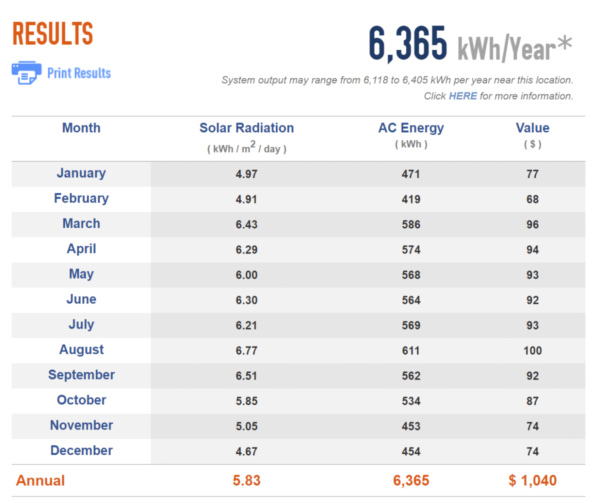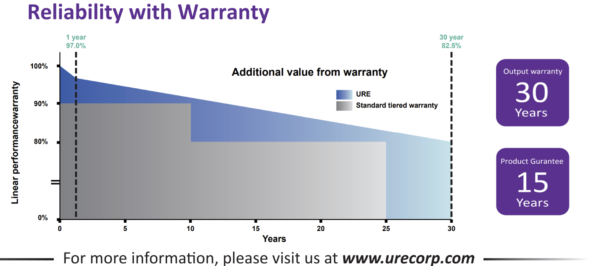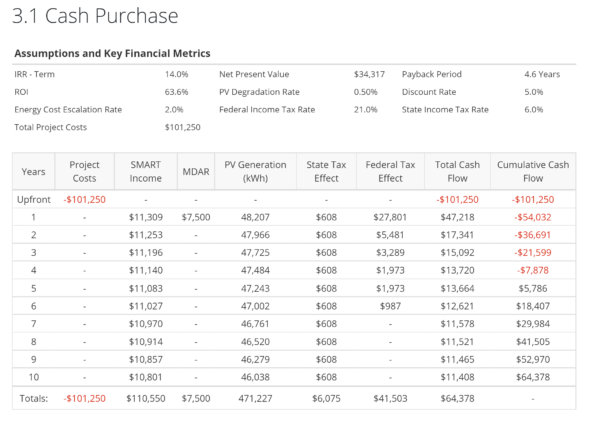Let’s get down to brass tacks: Exactly how long will it take your solar system to pay for itself?
There’s a decent chance your contractor will have a spreadsheet-style document with all the details you need to understand your payback period. That document will typically pull information from multiple resources and tools generally available to solar contractors.
For instance, when we worked the angles on our roof, we used a tool called PVWatts. This free government tool takes into account panel efficiency, location, angle, and regional weather averages to accurately predict how much electricity a particular solar system will generate. The local price of electricity is also built in, meaning you can find an estimated annual savings in less than a minute.

The simplest way to model the payback period is to divide the project’s costs by the expected annual production number offered by the calculator. That’s a good start, but it probably won’t tell us the whole story. Your actual payback period will need to consider tax credits, net metering, and state incentives.
Let’s start with the federal Residential Energy Efficient Property Credit. Currently, the tax credit is 26% of the solar power project’s total cost. In the case of a 4,000W system (which, when priced at around $3/watt represents a $12,000 purchase), the 26% credit would reduce the solar project’s cost by $3,120.

The next piece of the calculation – net metering – can get complex in some states. If you happen to live in a state where your net metered solar electricity is 100% compensated, then that’s an easy calculation. All of the electricity your solar panels export will be worth exactly the same as what you use immediately.
If you live in a state where net metered electricity exports are priced lower than the electricity that you buy from the grid, then you’ll need to estimate the difference. This isn’t easy to pin down without specialized hardware in place (like a solar inverter).
Historical averages have shown that close to half of solar generation will be used instantly, while the other half will likely be credited to your account, offsetting future use. Multiply the 50% that is used instantly by your full electricity rate, and the other 50% by the net metered rate offered in your state.
The sum of those two numbers represents the amount of money that you will save on your electricity bill over the next few decades, assuming that your state’s net metering agreement remains in place.
Keep in mind that your solar power system will degrade over time, lowering its electricity output. On average, solar degradation rates are 1-3% in the first year, and 0.5% in later years. That means that by year 25, your solar system will probably be operating at 85% of its original output.

The solar panel you buy will have a warranty that specifically references its degradation rate and expected lifespan.
Now, for our last calculation, state incentives. Each state is different. In Massachusetts, you get paid a bonus for each kilowatt-hour generated. In Rhode Island, you’re paid a fixed dollar amount, based on system size, that is disbursed immediately after the system connects to the power grid.
If you’re lucky enough to live in a state with incentives, you’re going to have to do a little homework to know the exact method to calculate the dollar amount. Our guide to state incentives is a good starting place to research these differences.
Most contractors will provide something like the chart below, which combines all the variables likely to affect your solar system’s prospective payback period. But now that you understand the math, you may want to create your own spreadsheet. After all, trust, but verify.

Here’s how it works. Start with the total cost of the system, then subtract the one-off items like the federal tax credit and state incentive. Next, divide by the estimated annual net-metered savings (plus any potential state incentives that we sorted out earlier), and voila! – that’s your payback period.
Your calculations should look a little less complicated than the payback table for a Massachusetts farmer (above). But with a little luck, the column on the far right – which adds up all savings, incentives, and revenue – will shift from red to black sooner than you may have expected.
This content is protected by copyright and may not be reused. If you want to cooperate with us and would like to reuse some of our content, please contact: editors@pv-magazine.com.








Or just use Energy Toolbase!
I think Energy Toolbase should combo with Helioscope or Aurora to offer a homeowner version for, like $25, that only lets them model their own home.